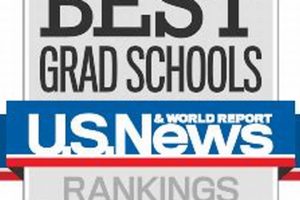The concept of evaluating and ordering medical institutions based on various performance indicators, including research output, student outcomes, faculty expertise, and resources, creates a hierarchy often used by prospective students, faculty, and the public. For example, factors such as average MCAT scores and GPA of matriculants, residency match rates, faculty awards, and research funding contribute to a school’s standing within these rankings.
Such evaluations provide valuable insights for prospective students navigating the complex medical school application process. These rankings can offer a framework for comparing institutions and identifying programs aligned with individual academic goals and career aspirations. Furthermore, institutional rankings often correlate with reputation and prestige, potentially impacting graduates’ career trajectories and access to competitive residency programs. Historically, formalized ranking systems for educational institutions emerged in the late 19th and early 20th centuries, evolving significantly with the rise of readily available data and increased public interest in educational quality.
Understanding the methodologies, strengths, and limitations of different ranking systems is essential. This exploration will delve into the prominent ranking bodies, common metrics employed, and the implications of these rankings for various stakeholders within the medical education landscape.
Successfully navigating the landscape of medical school rankings requires careful consideration of multiple factors beyond the overall rank. A thorough understanding of individual needs and priorities is paramount.
Tip 1: Define Personal Priorities: Identify individual academic and career goals. Research programs known for specific strengths, such as primary care, research, or a particular medical specialty. A school highly ranked overall may not be the optimal choice if it doesn’t excel in a desired area.
Tip 2: Examine Ranking Methodologies: Different ranking organizations employ varying methodologies. Understand the weighting assigned to specific factors, such as research output, student selectivity, or faculty resources. This knowledge allows for informed interpretation of the rankings.
Tip 3: Look Beyond Numerical Rankings: Consider qualitative factors like campus culture, learning environment, and available resources. Visiting schools, attending virtual information sessions, and connecting with current students and alumni can provide valuable insights not reflected in numerical rankings.
Tip 4: Focus on Fit: The “best” medical school is the one that best aligns with individual learning styles, career aspirations, and personal preferences. Consider factors like location, class size, and teaching methodologies.
Tip 5: Consider Residency Match Rates: Investigate the historical success of a school’s graduates in securing residencies in desired specialties. This data can be a crucial indicator of a program’s effectiveness in preparing students for their chosen career paths.
Tip 6: Don’t Overemphasize Minor Ranking Differences: Obsessing over small variations between schools can be counterproductive. Focus instead on the broader picture and how each institution aligns with individual goals.
By employing these strategies, prospective medical students can utilize rankings effectively as one component of a comprehensive approach to selecting the ideal institution for their medical education.
Ultimately, a well-informed decision requires a balanced approach, combining quantitative data from rankings with qualitative assessments of individual fit and institutional characteristics.
1. Reputation and Prestige
Reputation and prestige play a significant role in the perceived value and desirability of medical schools. These intangible qualities influence applicant choices, faculty recruitment, research funding opportunities, and even patient perceptions of physician competence. While not directly measurable, reputation and prestige are often correlated with quantifiable metrics used in ranking systems.
- Historical Performance:
Institutions with a long history of academic excellence, groundbreaking research, and prominent alumni tend to cultivate a strong reputation. For example, institutions like Harvard Medical School and the University of Pennsylvania’s Perelman School of Medicine benefit from a legacy of achievement that contributes significantly to their prestige. This historical context often translates into higher rankings.
- Faculty Accomplishments:
The presence of renowned faculty, Nobel laureates, and leaders in specific medical fields enhances a school’s reputation. Institutions like Johns Hopkins and Stanford attract top researchers and clinicians, contributing to their prestige and influencing their placement in rankings.
- Research Output and Funding:
Institutions actively engaged in cutting-edge research and receiving substantial funding from organizations like the National Institutes of Health (NIH) often enjoy elevated prestige. High research output correlates with a stronger reputation and typically contributes positively to rankings.
- Selectivity and Student Outcomes:
Highly selective admissions processes, resulting in a student body with exceptional academic credentials, contribute to a school’s perceived prestige. Furthermore, strong student outcomes, including high residency match rates and success in specialized fields, reinforce this perception and often correlate with higher rankings.
Ultimately, reputation and prestige, while subjective, exert a powerful influence on the landscape of medical education. These factors are intertwined with the quantitative metrics used by ranking organizations, creating a complex interplay that shapes public perception and influences the choices of prospective students and faculty alike. Understanding this dynamic provides valuable context for interpreting medical school rankings and making informed decisions.
2. Research Opportunities
The availability and quality of research opportunities are integral to the assessment and ranking of medical schools. Institutions fostering a robust research environment attract high-caliber faculty and students, contributing to advancements in medical knowledge and improved patient care. A strong research infrastructure often correlates with higher rankings and provides aspiring physicians with valuable training and experience.
- Infrastructure and Resources:
State-of-the-art laboratories, core facilities, and access to extensive research databases are essential components of a thriving research environment. Institutions like the University of California, San Francisco (UCSF) and the University of Michigan Medical School are renowned for their cutting-edge facilities, which enable complex research projects and attract significant funding. This robust infrastructure directly contributes to their prominent positions in rankings.
- Faculty Mentorship and Collaboration:
Opportunities to work alongside established researchers provide invaluable mentorship and training for medical students. Institutions like Washington University in St. Louis and Duke University School of Medicine prioritize faculty-student collaboration, fostering a culture of mentorship that enhances research productivity and student development, impacting their high rankings.
- Funding Opportunities:
Access to internal and external funding sources, including grants from the NIH and private foundations, is crucial for supporting innovative research initiatives. Institutions like the University of Pennsylvania and Columbia University Vagelos College of Physicians and Surgeons boast strong track records of securing research funding, enabling ambitious projects and attracting top researchers, contributing to their standing in rankings.
- Translational Research Focus:
Institutions emphasizing translational research, which bridges the gap between basic science discoveries and clinical applications, offer students unique opportunities to participate in research with direct implications for patient care. Mayo Clinic Alix School of Medicine and UCLA David Geffen School of Medicine are known for their strong focus on translational research, attracting students and faculty interested in directly impacting clinical practice. This emphasis often resonates with ranking methodologies focused on impactful research outcomes.
The strength of a medical school’s research program significantly influences its overall ranking. A robust research infrastructure not only fosters innovation and attracts top talent but also provides students with invaluable training experiences that prepare them for careers in academic medicine or specialized clinical practice. Institutions prioritizing research and offering diverse opportunities for student involvement often achieve higher rankings and are more competitive in attracting prospective students and faculty.
3. Faculty Expertise
Faculty expertise is a cornerstone of high-ranking medical schools. A distinguished faculty influences program quality, research output, and ultimately, student outcomes. Leading institutions attract and retain accomplished researchers, clinicians, and educators who contribute significantly to a school’s reputation and its position within national rankings. This concentration of expertise creates a rich learning environment, fosters innovation, and shapes the future of medical practice. The presence of Nobel laureates, members of prestigious academies, and leaders in specific medical fields enhances an institution’s standing and attracts top-tier students. For example, institutions like Rockefeller University, renowned for its small size and focus on biomedical research, consistently rank highly due to the exceptional expertise of its faculty.
The depth and breadth of faculty expertise are key considerations in ranking methodologies. Rankings often assess faculty accomplishments, including publications, grants, awards, and leadership roles within professional organizations. A faculty actively engaged in cutting-edge research and contributing to advancements within their respective fields elevates a school’s ranking. Furthermore, faculty experience and pedagogical skills are essential for effective teaching and mentorship. Institutions like the University of California, San Diego, recognized for its collaborative research environment and commitment to innovative teaching methods, demonstrate how faculty expertise translates into high-quality education and improved student outcomes. This commitment to both research and teaching excellence strengthens an institution’s reputation and its standing within rankings.
Understanding the link between faculty expertise and medical school rankings provides valuable context for prospective students evaluating programs. While overall rankings offer a general overview, investigating the specific strengths and accomplishments of a school’s faculty offers deeper insight into the quality of education and training provided. Institutions prioritizing faculty development and supporting their pursuit of groundbreaking research often achieve higher rankings and contribute significantly to the advancement of medical knowledge. This focus on faculty expertise fosters a stimulating academic environment and equips future physicians with the skills and knowledge necessary to excel in a rapidly evolving healthcare landscape.
4. Student Outcomes
Student outcomes represent a critical factor in evaluating and ranking medical schools. These outcomes, encompassing metrics such as residency match rates, board certification pass rates, and career trajectories, offer insights into the effectiveness of a school’s curriculum, faculty mentorship, and overall educational environment. High-ranking institutions often demonstrate a strong correlation between their educational programs and successful student outcomes. For example, schools like Massachusetts General Hospital, Brigham and Womens Hospital (Partners) and the University of California, San Francisco, consistently place graduates in highly competitive residency programs, reflecting positively on their rankings. Cause and effect relationships exist between student outcomes and a school’s ranking: strong outcomes contribute to a higher ranking, while a high ranking attracts high-achieving applicants, potentially leading to further positive outcomes. This cyclical relationship reinforces the importance of student outcomes as a key component of ranking methodologies.
The importance of student outcomes extends beyond their impact on rankings. These metrics offer prospective students valuable data for assessing the potential return on their educational investment. High residency match rates in desired specialties, for example, signal a program’s effectiveness in preparing graduates for competitive career paths. Moreover, strong board certification pass rates reflect the quality of the education received and can influence future career prospects. Understanding these outcomes provides prospective students with practical insights for making informed decisions about their medical education. Analyzing long-term career trajectories of alumni, including their contributions to research, clinical practice, and leadership roles within the medical field, provides a broader perspective on the lasting impact of a medical school education.
In summary, student outcomes serve as a critical component of medical school rankings, reflecting the quality and effectiveness of educational programs. Analyzing these outcomes, including residency match rates, board certification pass rates, and career trajectories, offers valuable insights for both prospective students and the broader medical community. While challenges exist in accurately measuring and comparing student outcomes across different institutions, their significance remains undeniable. Understanding the relationship between student outcomes and medical school rankings empowers prospective students to make informed decisions aligned with their career aspirations and contributes to the ongoing evaluation and improvement of medical education.
5. Resource Availability
Resource availability significantly influences medical school rankings and educational quality. Ample resources, encompassing cutting-edge facilities, technological infrastructure, well-stocked libraries, and robust financial support, enable institutions to attract top faculty, conduct groundbreaking research, and provide students with exceptional learning opportunities. This positive correlation between resource availability and institutional ranking is evident in institutions like the University of Texas Southwestern Medical Center and Yale School of Medicine, which are known for their extensive resources and consistently achieve high rankings. Cause and effect relationships exist: ample resources attract high-quality faculty and students, leading to better outcomes and higher rankings; conversely, high rankings can facilitate increased funding and resource acquisition. This cyclical nature emphasizes resource availability as a crucial component of top-tier medical education.
The practical significance of resource availability extends beyond its impact on rankings. Access to advanced simulation centers, specialized laboratories, and extensive electronic medical records allows students to develop practical skills and engage in hands-on learning. Furthermore, substantial financial resources can support scholarships, research grants, and innovative educational programs, enhancing the overall student experience. For instance, institutions like Emory University School of Medicine and Vanderbilt University School of Medicine leverage their resources to offer diverse educational opportunities, contributing to their strong reputations and high rankings. Understanding the role of resources in medical education allows prospective students to evaluate programs based on their capacity to provide a comprehensive and enriching learning environment. This understanding emphasizes the importance of considering not only overall rankings but also the specific resources available at each institution.
In summary, resource availability plays a crucial role in medical school rankings and the overall quality of medical education. A well-resourced institution can attract and retain leading faculty, conduct impactful research, and offer students a richer learning experience. While challenges exist in quantifying and comparing resource availability across different institutions, its influence on educational outcomes remains substantial. This understanding empowers prospective students to evaluate programs based on their capacity to provide a supportive and stimulating learning environment, contributing to their future success in the medical field. Furthermore, recognizing the connection between resource availability and institutional rankings underscores the importance of continued investment in medical education to foster innovation and excellence in patient care.
6. Clinical Training Quality
Clinical training quality stands as a pivotal factor influencing medical school rankings and, more importantly, the development of competent and compassionate physicians. Robust clinical experiences, provided within diverse healthcare settings and under the guidance of experienced clinicians, shape students’ diagnostic skills, clinical reasoning, and patient management abilities. A strong correlation exists between the quality of clinical training and a school’s overall ranking. Institutions like the University of Washington School of Medicine and the University of Chicago Pritzker School of Medicine, renowned for their exceptional clinical training programs, consistently secure high rankings. This connection arises from a cause-and-effect relationship: high-quality clinical training leads to better student outcomes, including strong residency placements and board exam performance, which in turn contribute to higher rankings. Conversely, high rankings can attract more funding and resources, further enhancing clinical training opportunities. This reciprocal relationship underscores the importance of clinical training quality as a key component of “best medical schools in the US ranked.”
The practical significance of robust clinical training extends beyond its impact on rankings. Early and extensive exposure to diverse patient populations and clinical scenarios equips students with the practical skills and experience necessary to navigate the complexities of medical practice. Access to high-volume teaching hospitals, specialized clinics, and community health centers allows students to develop proficiency in various medical specialties and gain exposure to different healthcare delivery models. Institutions like Baylor College of Medicine and Icahn School of Medicine at Mount Sinai, with their strong affiliations with major medical centers, offer students rich clinical experiences that contribute significantly to their professional development and preparedness for residency training. This practical training translates into improved patient care and better physician preparedness, underscoring the vital role of clinical training quality in shaping future healthcare professionals.
In summary, clinical training quality serves as a critical component of medical school rankings and, more fundamentally, the formation of skilled and compassionate physicians. Strong clinical experiences, provided within diverse healthcare settings and under expert guidance, cultivate essential clinical skills, enhance professional development, and ultimately contribute to improved patient care. While challenges exist in standardizing and assessing clinical training quality across different institutions, its significance remains paramount. Recognizing this connection empowers prospective students to evaluate programs based on the strength and breadth of their clinical offerings, contributing to their future success as physicians. Furthermore, the link between clinical training quality and institutional rankings emphasizes the ongoing need for innovation and investment in clinical education to meet the evolving demands of the healthcare landscape.
7. Admission Selectivity
Admission selectivity acts as a critical filter, shaping the student body composition and influencing the academic environment within top-ranked medical schools. A highly selective admissions process, often characterized by stringent academic requirements, rigorous evaluation of extracurricular activities, and in-depth interviews, shapes the caliber of incoming students and contributes significantly to a school’s overall ranking. This selectivity reinforces a competitive academic atmosphere, fosters a culture of high achievement, and ultimately contributes to positive student outcomes. The relationship between selectivity and ranking is bidirectional: high rankings attract a larger pool of highly qualified applicants, increasing selectivity, while a highly selective admissions process contributes to a school’s prestige and ranking.
- Academic Metrics:
High GPA and MCAT scores are often prerequisites for admission to top-ranked medical schools. These metrics serve as initial filters, reflecting an applicant’s academic aptitude and potential for success in a rigorous medical curriculum. Institutions like Harvard Medical School and Stanford University School of Medicine, renowned for their high selectivity, typically admit students with exceptional academic records, contributing to their competitive academic environments and high rankings.
- Experiential Diversity:
Beyond academic metrics, admissions committees seek applicants with diverse experiences, including research involvement, community service, leadership roles, and exposure to clinical settings. These experiences demonstrate an applicant’s commitment to medicine, well-roundedness, and potential to contribute meaningfully to the medical profession. Schools like the University of California, Los Angeles, David Geffen School of Medicine and the University of North Carolina School of Medicine value experiential diversity in their admissions processes, enriching the learning environment and fostering a diverse student body.
- Personal Qualities:
Assessing personal qualities, such as communication skills, empathy, resilience, and ethical reasoning, is crucial for identifying candidates who possess the attributes necessary to become compassionate and competent physicians. Institutions like Johns Hopkins University School of Medicine and the University of Pennsylvania Perelman School of Medicine prioritize these qualities during the interview process, seeking individuals who demonstrate strong interpersonal skills and a genuine commitment to patient care.
- Letters of Recommendation and Essays:
Strong letters of recommendation from professors and mentors who can attest to an applicant’s academic abilities, character, and potential for success in medicine are essential components of the application process. Well-crafted essays provide applicants with an opportunity to showcase their unique experiences, motivations for pursuing medicine, and alignment with a school’s mission and values. These qualitative assessments play a significant role in the admissions decisions of highly selective institutions like Columbia University Vagelos College of Physicians and Surgeons and Duke University School of Medicine.
The high selectivity of top-ranked medical schools creates a competitive environment that attracts high-achieving students, fosters intellectual curiosity, and cultivates future leaders in medicine. While academic metrics play a significant role in the admissions process, a holistic review considers diverse experiences, personal qualities, and demonstrated commitment to the medical profession. Understanding the multifaceted nature of admission selectivity provides valuable insights for prospective applicants seeking admission to the nation’s most prestigious medical schools. This selectivity, while challenging to navigate, ultimately contributes to the high quality of education and training offered by these institutions and their prominent position within national rankings.
Frequently Asked Questions about Top Medical School Rankings
This section addresses common inquiries regarding medical school rankings, providing clarity and context for prospective students navigating the complex landscape of medical education.
Question 1: How significantly should rankings influence medical school selection?
Rankings offer valuable data points for comparison, but they should not be the sole determinant. Individual priorities, career goals, learning styles, and institutional culture should be weighed heavily.
Question 2: Do all ranking systems utilize the same criteria?
No, different ranking organizations employ varying methodologies and weight different factors, such as research output, student selectivity, faculty resources, and clinical training quality. Understanding these methodologies is essential for interpreting rankings accurately.
Question 3: Is there a significant difference between schools ranked closely together?
Marginal differences in ranking often reflect nuanced variations rather than substantial disparities in quality. Focusing on individual fit and specific program strengths is more crucial than fixating on minor ranking differences.
Question 4: How can one assess factors not reflected in rankings, such as campus culture?
Visiting schools, attending virtual information sessions, and connecting with current students and alumni can offer valuable insights into the learning environment, campus culture, and student experiences not captured by numerical rankings.
Question 5: Do rankings accurately reflect the quality of clinical training provided?
Rankings often incorporate metrics related to clinical training, such as faculty expertise and affiliated hospital quality. However, direct assessment of clinical experiences requires further research, including reviewing residency match rates and exploring clinical opportunities offered by each institution.
Question 6: How frequently are medical school rankings updated?
Most major ranking organizations update their rankings annually, reflecting changes in institutional performance, faculty composition, and student outcomes. Consulting the latest rankings available is crucial for accessing the most current information.
Careful consideration of these frequently asked questions, coupled with thorough research and self-reflection, empowers prospective students to navigate medical school rankings effectively and make informed decisions aligned with their individual needs and aspirations. A balanced approach, incorporating both quantitative data and qualitative assessments, leads to the most informed decisions.
For further information on specific aspects of medical school selection, explore the subsequent sections addressing application strategies, financial aid considerations, and preparing for the rigors of medical education.
Exploring the landscape of top medical schools requires a nuanced understanding of the various factors contributing to institutional rankings. Reputation, research opportunities, faculty expertise, student outcomes, resource availability, clinical training quality, and admission selectivity all play significant roles in shaping a medical school’s standing. While rankings provide a valuable framework for comparison, they should be interpreted judiciously, considering individual priorities, career aspirations, and the unique characteristics of each institution. A balanced approach, combining quantitative data from rankings with qualitative assessments of individual fit and institutional culture, is essential for making informed decisions.
The pursuit of medical education represents a significant investment, both personally and professionally. A thorough understanding of the factors influencing medical school rankings empowers prospective students to navigate this complex landscape effectively. Ultimately, the “best” medical school is the one that best aligns with an individual’s learning style, career goals, and personal values. Prospective students are encouraged to engage in comprehensive research, attend virtual information sessions, visit campuses, and connect with current students and alumni to gain a deeper understanding of each institution and make informed decisions that shape their future careers in medicine. The future of healthcare rests on the shoulders of well-trained and compassionate physicians, and selecting the right medical school is a crucial step in this journey.







